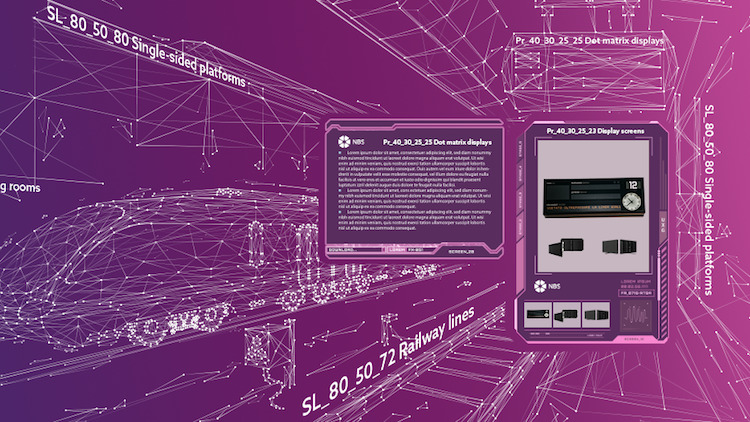
That Uniclass 2015 is the classification system used to organise information across all construction industry disciplines is something of a given, but how else can the system be used?
To find out more, BIMplus grabbed a few minutes with Tina Pringle, who is not only director of technical information at NBS, but also a member of the team that devised Uniclass 2015.
Perhaps we ought to start with a reminder of Uniclass’s role
Used as a way to identify and manage the vast amount of information that’s involved in a construction project, Uniclass is also a requirement for BIM projects as set by the ISO 19650 series of standards.
In short, the classification of objects and assets is allowing for greater consistency and a ‘shared language’ among companies and organisations, resulting in a more standardised approach, easier communication and more robust record keeping. It contains tables classifying items of any scale, from a large facility such as a railway, down to products such as a CCTV camera in a railway station. The classifications within the tables allow buildings, landscape and infrastructure to be classified under one unified scheme.
Last year we reported on Uniclass being used to classify Parliament’s treasures: who else is using the system in a different way?
The Environment Agency has been smart in its approach to the huge amount of physical asset information that its team manages. Be it embankments, flood defences or weirs, handling this bank of assets would be nigh on impossible without a detailed but comprehensible classification system like Uniclass.

‘Galliford Try is using Uniclass in a wider remit, using the classification system to identify objects beyond BIM models.’
As my colleague Sarah Delany, head of classification at NBS, puts it: “The Environment Agency has taken one step back and has considered ‘what assets have we got across the country and what information do we need about those assets?’”
Central to managing this process is the quality of data it receives. Through its Data Requirements Library, an online system that specifies how information is to be delivered to the agency digitally, it automates the generation of asset data rather than the time-heavy traditional approach of interrogating drawings to collect it manually.
Once this information arrives, Uniclass is then used to organise this information not only to better identify the assets it has, but also to make the managing, handling and sharing of data between organisations much easier.
The result is a more informed decision-making process and an optimal use of time in digital automation.
We hear it’s being used in Australia
Transport for New South Wales (TfNSW), an extensive transport system for the state of New South Wales, is constantly looking to improve its infrastructure delivery and asset-owner outcomes through the implementation of digital engineering.
With multiple classification systems in place within its transport cluster, it meant that significant efforts and costs were needed to maintain and align the organisation. To overcome this issue, it turned to Uniclass, delivering a uniform classification system, one that could be used as a blanket point of reference to avoid any would-be confusion or mistakes.
In its 2016 report, it recommended that “detailed classification should be a critical part of its project planning and execution” and that a standardised approach to providing “a common language for people, construction and managing assets is needed”.
Through opting to use Uniclass as its classification system, time efficiency and accuracy has greatly improved. It’s also become vital to its ‘search and retrieve’ database of documents that contains the likes of design models, project information and asset registers.
Crucially, opting for Uniclass is accommodating TfNSW’s future growth plans through easier classification and a more uniformed approach.
Who else is pushing the envelope with Uniclass?
Galliford Try is using Uniclass in a wider remit, using the classification system to identify objects beyond BIM models. With an extensive range of clients, it means that a common language must be used throughout its internal and external communications.
As part of its ISO 19650 certification and to manage its many cross-sector projects, it uses its Design Responsibility Matrix and Master Information Delivery Plan based on Uniclass. These are data-heavy, complex document guides that not only help the construction process, but also help inform their work package and information requirements when working with many different clients. Through the Uniclass classification system, this information can be more easily located and tracked.
The use of Uniclass even extends to changes evolving from the Building Safety Bill, and incorporated into Galliford Try’s quality check sheets and handover requirements. Speaking at a recent webinar, Adrian Shilliday, technical director at Galliford Try, said: “Off the back of the Building Safety Bill, there’s been a huge focus on quality, fire-stopping and fire performance products, and we need to ensure we have the required quality records, as well as collected data to feed back into models and specifications to ensure that we are providing all of the handover information in the correct format.
“As a contractor, we see huge benefits through Uniclass, as well as some challenges of wider industry adoption. By having a standardised approach to specification and classification, all the way through to products and project management tables, we can start to embed further project efficiencies, greater use of digital tools and reporting. It’s now vital to our process of handovers, performance, fire safety, acoustic analysis and carbon measurement.”
Can the Uniclass team at NBS sit on its laurels?
While Uniclass has seen rapid adoption in recent years, with those using the system now seeing it as invaluable to the functionality and smooth running of their businesses, there still remains some hesitancy from built environment professionals unsure of how to bring the Uniclass tables into practical use.
As Uniclass becomes embedded in software workflows, its popularity is rising and the examples I’ve listed merely scratch the surface of its uses. It’s also proving to be instrumental in bringing government and industry together, allowing them to work side-by-side.
It also represents an important piece of the puzzle when achieving the Golden Thread, allowing greater insight into the decision-making process, leading to greater degrees of safety and build quality.
Finally, Uniclass has future plans to constantly evolve its offering: with Process Activities and Properties and Characteristics soon to be added into its list of tables, a deeper level of the process of delivery not just the identification of the asset is set to make Uniclass even more effective.
The launch of the Uniclass Advisory Board is also a marker of intent, continuously improving the system’s capabilities to drive up construction quality across all areas of built environment.
Don’t miss out on BIM and digital construction news: sign up to receive the BIMplus newsletter.














